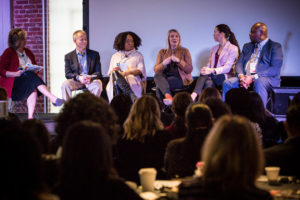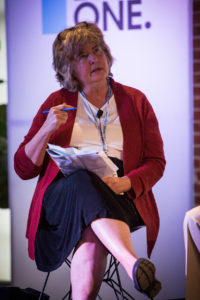Corporate Culture: Why It Can Pay to Put Employees First


While almost everyone agrees that a company’s culture is the No. 1 key to its long-term success, the best expression of that culture is probably not platitudes but programs–real things a business does to show its workers and other stakeholders what it believes in. What does the fabric of culture look like?
Imagine having a direct pipeline to your CEO when you’re in unexpected financial straits–a way to apply immediately for an emergency monetary grant.
Or access to a dedicated whistleblower channel encouraging employees to report anything they consider unethical, immoral, improper, or unsafe.
Or a “social good” program to support community work, a program so essential to a new company that it’s launched even before the company starts taking on paying customers?
Those were some of features of corporate culture described by executives on a panel discussion at From Day One’s conference in Los Angeles. The panel, titled “Crafting a Corporate Culture That Means Something,” was moderated by Los Angeles Times writer Margot Roosevelt.
Many of their examples focused on the well-being of employees. “There’s certainly a lot of research out there … that suggests that taking care of your employees, taking care of your own, does also benefit your shareholders,” said Sarah Townsend, assistant professor of business administration at the University of Southern California. “So one of the ways of maximizing revenues is also to make sure that … the communities you serve are doing well, and that your employees are feeling that they belong and can perform well because of that.”
Ronald Reeves, head of diversity and inclusion at insurance giant AIG for the U.S. and surrounding regions, pointed out the importance of bolstering the passions of younger, motivated employees when it comes to giving back to the community, even taking into account the need to produce healthy profits for stockholders.
“We want AIG’s shareholders to make money, but it’s also being driven a lot by our employee-resource groups (ERGs),” Reeves said, referring to the priorities of what he called the “I Generation,” as in: “I want technology, I want diversity, and I want to be able to give back to the community and do meaningful work.”

He added: “A lot of the organizations that we supported in the past, they were some of the pet projects of our most senior executives. What we love about our employee resource groups [is that] we actually give them the funding to make an impact,” said Reeves, with company leaders asking questions like, “What are the trends that we are seeing that our employees are passionate about? And how do we make a bigger investment, whether that’s with resources or money?”
Listening is key, he said–an imperative echoed by the other panelists. Live Nation, for example, has implemented programs suggested by employees, taking a grassroots approach. The company, while focused on acquisitions and the continued independence of subsidiaries, strives to achieve employee satisfaction across its range of business entities, said Elizabeth A. Morrison, Live Nation’s VP of diversity and belonging.
The company’s initiative called Taking Care of Our Own, through which employees can email the CEO, often results in staff members in financial distress receiving “a grant from the company that is a gift,” Morrison said. “It’s not a loan. There is no interest. There’s no payback. There’s no penalty–and not only is it utilized, but there’s a halo effect from that, with employees literally seeing in real time that a company cares about them and is willing to invest in them.”
She added: ‘We also go really above and beyond when it comes to our benefits, in terms of being inclusive … [the company is] expanding to six months paid maternity leave. We’re also really invested in growth and development programs,” Morrison said, pointing to mentorship and mental-health programs suggested by Live Nation employees.
Bernie C. Knobbe, head of global benefits at the engineering giant AECOM, highlighted the importance of mental and physical health awareness within the company, citing research.
“We did use the data that said shareholder value is increasingly focused on employees’ focus and well-being,” Knobbe said. “And we needed that substantiation to actually do what we wanted to do. We also looked at our claim information for three years and realized that people who participated in the wellness program had 18% lower health-care costs than employees who did not. Those are the data points that you need to even start.”
Knobbe said that he was “realistic but optimistic” about the program, which keeps growing in scope. “We went from a Global Well-being Day to a Global Well-being Week and this year it was a Global Well-being Month–because we couldn’t get it all in.”
Crafting the corporate culture, however, doesn’t have to focus just on employee and employer, said Meagan Dorsch, head of social good at the new wireless network Visible. “Getting a wireless subscription or service is very complicated,” says Dorsch, whose company is a subsidiary of Verison and focused on affordable service, with a particular focus on younger customers. “The field is very crowded, and the onus has been put on the consumers to figure out what’s best for them. So one of the goals in launching Visible was to make it easy, simple,” she said.
“What we did is turn to our members–that’s what we call our customers–and said: ‘What do you want from a wireless provider?’ And we heard things like: ‘We want a WiFi hotspot, we want family plans that aren’t for families.’ So these are things we’ve rolled out in the last nine months to our consumers.” The company takes the same approach to its social-good programs, said Dorsch. “We ask our consumers again: ‘What change do you want to see? What do you want to be a part of?’”

Another important aspect of corporate culture is taking a broad approach to diversity and inclusion. “One of the other sort of unseen, subtle areas of inclusion that I’ve looked at is social-class diversity, outside the typical race, gender [categories] that we talk about. People that are the first in their families to go to college–they have a college degree but are from a working class, lower-income background,” she said. People from a blue-collar background, where individualism is highly valued, may have trouble fitting into a global corporation that puts an emphasis on collaboration among its global workforce. “And that’s very attractive to that population, but what we’re finding is, if you don’t back that up with having employees actually working together and collaborating, that this disconnect–what you say you’re valuing and what people are actually doing day-to-day–causes issues,” Townsend said.
That kind of disconnect has a measurable downside, she said. “People who are in corporations where they say they value cooperation but are not actually working with others on a day-to-day basis show 13% greater turnover intentions.”
In a keynote address that followed the panel, Rajeev Peshawaria, CEO of the Iclif Leadership and Governance Centre, gave a presentation based on his book Open Source Leadership: Reinventing Management When There’s No More Business as Usual.
Sheila Flynn is a New York-based journalist who has written for DailyMail.com, the Irish Daily Mail, and the Associated Press. She is a graduate of the University of Notre Dame
The From Day One Newsletter is a monthly roundup of articles, features, and editorials on innovative ways for companies to forge stronger relationships with their employees, customers, and communities.